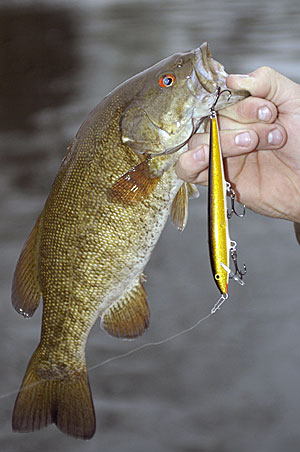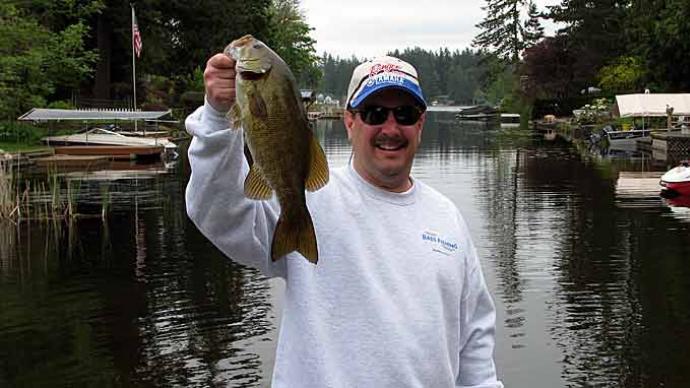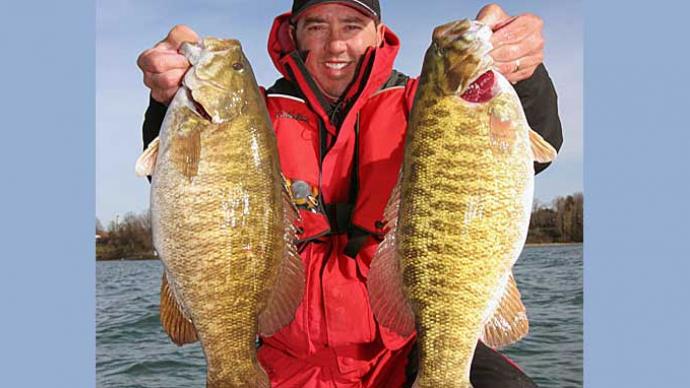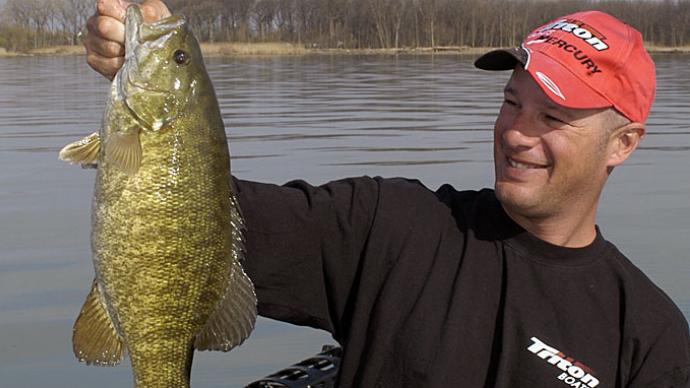
Bass anglers in the Great White North can’t wait to get on the water once the ice melts. With water temperatures still ice cold, where do you start looking? It depends on the body of water. The vast expanses of the Great Lakes are slow to warm.
Smallies could still be in their deep winter haunts when you first get on the water, or they could be inching towards where they will spawn in a month or two and stop to forage somewhere in between. Bass in large rivers may migrate far downstream from where they’ll spend the warmer months in slow-moving holes in the river's lower portion. Smallies in natural lakes and reservoirs could still be in deep water and winter haunts. Or not.
Smallmouths will be headed to the shallows on larger natural lakes and reservoirs to find warmer temperatures and forage when things start to warm up in April. At what point they are in the transition is the million-dollar question. The best you can do is play the wind and hope it stacks warmer surface water against the shoreline. A south blow and bright sunshine can quickly warm the shallows of a south-facing shoreline and beckon to frostbitten bass. The idea is to start shallow, but if you don’t find what you’re looking for, don’t be afraid to go to where you last fished in the fall.
Just how strong sunshine can be was illustrated on a trip my son Matt and I made with guide Dave Rose a few years ago. We were targeting bass on some northern Michigan lakes in late spring. This part of Michigan has dozens of clear lakes with excellent habitat for smallies and are known for producing big catches.
We got on the water fairly early and headed to one of Rose’s favorite smallmouth waters. After several hours of fishing produced only one small walleye, we loaded to boat up and headed to another lake a short distance away. We continued to probe rocky structure, drop-offs, and main lake points that you knew had to hold bass. It was mid-afternoon, and we were still drawing a blank.
Rose pointed the boat toward shore, reasoning that they might be shallow if the bass weren’t deep. There wasn’t any real reason for the bass to be there. The water was crystal clear on the flats with shallow, barren, undulating sand for 200 yards to the shoreline with only the occasional log for cover. However, the temperature gauge slowly inched up to 56 degrees, two degrees warmer than anywhere else we’d fished that day. The dark logs likely absorbed even more heat from the spring sunshine.
Rose moved us along with his trolling motor as we cast to the visible logs. I could make out a shadow near one of the logs, thinking I might be hallucinating. I cast my tube jig towards the log, and the “shadow” zoomed over and ate it. We caught a dozen bass before we quit by working the warmer flats and looking for isolated logs and cruising smallies. Water temperature is critical anytime you’re searching for spring smallmouths. The warmer, the better until the spawn is done.

Intense spring sunshine can quickly warm shallow water, and wind can amplify the results. Warm water is less dense than cold water and is more easily moved. South–facing bays are the place to begin your search on any lake, especially if you’ve had several days of sunshine and strong south winds. Warm surface water will pile up in the bays attracting both bass and baitfish.
Crayfish will venture out of hiding too to forage in the tepid water. The scenario is even better if spawning habitat can be found a short distance away. A strong north wind will undo everything. The warm water will be pushing out deep, and cold water will replace it. The best thing to do then is to head deeper to the first drop-off and structure and slow down your presentation. The once aggressive bass will now be tight-lipped.
Smallmouths in moving water are not above traveling to find the right conditions. Smallmouth are more migratory than many people think. Studies done at Waugoshance Point in Michigan showed that some bass migrated over 90 miles to find suitable habitat. Bass in rivers will migrate downstream to find slow, deep pools where they can spend the cold months in a state of winter inactivity. The ideal habitat has boulders, ledges, and rocks where bass can get out of the current. Habitat like this is ideal for winter quarters but is not suitable for spawning, so as spring approaches, bass move upstream to find small rocks, cobble, and gravel where they can spawn successfully.
In between, bass put on the feedbag. Smallies gulp anything they can catch on their upstream migration to build up energy for the spawn. Anglers can take advantage of this heightened activity level if they can locate where the bass are in their journey. Sometimes it takes some searching. If the water is high, bass will hug the edges taking the path of least resistance. Often, anglers who target smaller streams for bass will have poor luck early in the season. That’s because the bass aren’t there! It’s no coincidence that stream fishing for smallmouths is best during the summer heat. Often that’s when the bass have finally made it back to their summer habitat after spending the cold months downstream in deeper pools.
I learned about the effects of wind and catching fish on the Great Lakes, being a charter boat captain for 25 years. Although I was chasing trout and salmon then, the effects of wind and how it determines fish location on the Great Lakes are no different for smallmouth bass.
The on-shore wind will cause warmer surface water to stack up on the windward sides of points, islands, and shoals and in shallow bays. The key is the temperature difference. It might be the change between 38 and 42 degrees or 48 and 52, but the difference is what attracts cold-blooded fish. If the wind is sustained for several days, the temperature change will be even more significant, and the fishing is likely to be surreal. In spring, you need to rely on your temperature gauge as your depth finder, especially on the Great Lakes.




